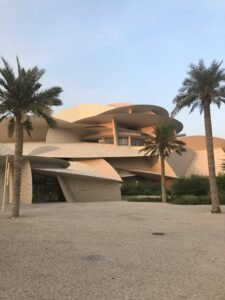Have you ever walked into a building and felt like you’ve stepped into the future and the past at the same time? That’s exactly how I felt when I first visited the National Museum of Qatar. It’s not just another stop on a tourist itinerary—it’s an experience that changed how I think about museums altogether.
A Desert Rose in the City

From the moment you catch your first glimpse of the museum, you know you’re in for something special. Designed by renowned architect Jean Nouvel, the building itself is a work of art inspired by the desert rose—a natural crystal formation found in Qatar’s arid landscape. Imagine interlocking discs of varying sizes creating a structure that seems to both rise from and belong to the desert.
Walking around the exterior, I couldn’t help but take dozens of photos, trying (and failing) to capture the way sunlight plays across the unique surfaces. Each angle reveals something new, making it a photographer’s dream and an architect’s masterpiece.
History Reimagined

Inside, the museum tells Qatar’s story in a way I’ve never experienced before. Forget dusty display cases and tiny information cards! Here, history comes alive through immersive experiences that engage all your senses.
The journey begins millions of years ago with Qatar’s geological formation and takes you through to the present day. What struck me most was how seamlessly the exhibits flow into one another—just like the narrative of Qatar itself.
One moment I was watching life-sized projections of pearl divers plunging into azure waters, feeling the rhythm of their work songs surrounding me. The next, I was standing in a recreated majlis (traditional sitting room), learning about the importance of hospitality in Qatari culture while actual scents of cardamom coffee filled the air.
Beyond Artifacts: Stories That Connect
What makes this museum truly special isn’t just what it shows, but how it shows it. Every artifact has a story, every display a personal connection. I watched children and adults alike become completely absorbed in the interactive exhibits.
The Pearl Carpet of Baroda particularly took my breath away—a masterpiece containing 1.5 million Gulf pearls, rubies, and emeralds that speaks volumes about Qatar’s pearling history. Standing before it, I could almost hear the stories of the divers who risked everything to harvest these treasures from the sea.
A Museum That Embraces Technology
Museums often struggle to balance tradition and technology, but Qatar’s National Museum has mastered this delicate dance. Throughout my visit, I encountered cutting-edge digital displays that enhanced rather than distracted from the historical content.
In one gallery, I waved my hand to activate a digital wall that revealed layers of archaeological findings. In another, a stunning 360-degree video installation transported me to the midst of a traditional pearl diving expedition. These technological touches never felt gimmicky—instead, they served as windows into Qatar’s past.
The Heart of the Museum
At the center of this modern marvel lies something much older—the restored Palace of Sheikh Abdullah bin Jassim Al Thani. This traditional building once served as both the ruler’s home and the seat of government. Walking through its rooms, I felt the powerful contrast between old and new Qatar, all housed under one spectacular roof.
The palace provides a grounding force amid the museum’s futuristic design, reminding visitors that Qatar’s rapid development remains rooted in its heritage.
Not Just a Museum—A Community Space
What impressed me most was how the museum serves as a gathering place for both visitors and locals. During my visit, I saw school groups engaged in workshops, researchers using the library facilities, and families enjoying the beautiful park spaces surrounding the building.
The cafés and restaurant offered a perfect spot to reflect on the experience while enjoying traditional Qatari dishes with modern twists. Even the gift shop transcended the usual tourist fare, offering beautifully crafted items that celebrated Qatar’s cultural heritage.
Plan Your Visit
If you’re planning to visit Qatar, I can’t recommend this museum enough. Here are some quick tips:
- Allow plenty of time: You’ll want at least 2-3 hours to fully experience the exhibits
- Join a guided tour: The insights from local guides add tremendous value
- Visit on weekdays: For a more peaceful experience with fewer crowds
- Don’t miss the outdoor spaces: The gardens and harbor views are stunning
- Stay for sunset: The building transforms as the light changes
The Future of Cultural Tourism
As I reluctantly left the National Museum of Qatar, I understood why it’s redefining cultural tourism not just in the region but globally. This isn’t a place that simply preserves the past—it celebrates it while simultaneously embracing the future.
In a world where authentic cultural experiences are increasingly valued, Qatar has created something genuinely special. The museum doesn’t just tell Qatar’s story; it invites visitors to become part of that ongoing narrative, creating connections that travel guides and standard tourist experiences simply can’t match.
Have you visited the National Museum of Qatar? I’d love to hear about your experience in the comments below!




